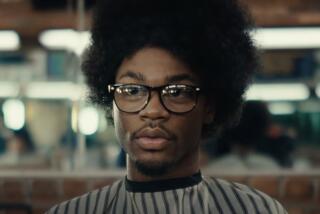Madison Ave. Plugs Into Home Videos
- Share via
Jeff Machkoff was bopping around in his Toyota Tercel early this summer when a radio ad caught his attention. He only heard part of it--something about Toyota looking for consumers to create their own commercials. That was enough to set his creative wheels spinning.
Machkoff, a struggling rap singer in search of an audience, decided to create a rap song that Toyota executives couldn’t ignore. It is, after all, no mean feat for a rap singer from Irvine--hardly the hip-hop capital--to get noticed. So the sophomore at Cal State Fullerton found a friend with a camcorder who filmed Machkoff and his pal performing the Toyota rap.
Three months later, their “Toyota-With-a-T” rap is aired in Southern California almost daily. So are seven other ads that consumers sent to Toyota. “Toyota got what it wanted--a cheap ad,” said Machkoff, who was paid $800 for his efforts. “And our band (Soul Survivors) got what we wanted--a stepping stone to bigger things.”
Madison Avenue has only recently caught on to the home video revolution that several years ago found its way into TV shows, nightly newscasts and movie theaters.
It should be no surprise that it took this long. Most ad agencies regard the home video as an anathema since it threatens the ad world’s shaky grasp on the mantle of creativity. Why should advertisers pay agencies thousands of dollars to create video images that consumers are only to happy to supply them for free?
Toyota isn’t the only advertiser to recently ask the public to create TV spots to help it sell its product. Pepsi held a similar competition for its “Uh-huh” slogan last year that attracted more than 4,000 entries. And, earlier this summer, the Democratic National Committee sponsored an amateur video competition called “30 Seconds Over Washington,” in which consumers were encouraged to send 30-second TV spots with the lure of a $5,000 cash prize.
When advertisers ask consumers to do their jobs for them--by creating ad videos--they face big risks, marketing experts say. “The idea is to extend spontaneity into ads,” said Michael Kamins, professor of marketing at USC. “But if you depend on consumers, you lose all control over what you want to say.”
Besides, consumers don’t usually do such a hot job creating ads. Toyota could only find eight broadcast-worthy ads out of the 150 entrees it received--and even then, only after heavy editing. Pepsi was so disappointed with the quality of the ads it received that, instead of airing a single winning ad, it was forced to splice brief moments from 10 of them together into one 30-second spot. And the Democrats too have given no indication that they will air any of the contest winners.
The home video phenomenon first caught the nation’s attention in 1989 with the premiere of the TV show “America’s Funniest Home Videos.” That show has since been much mimicked by half a dozen also-rans, including this season’s you-are-there offering, “Eyewitness Video.”
It was the home video that made Rodney King a household word--and Los Angeles a national flash point of unrest. Home videos continue to make the evening news almost nightly with short segments of everything from full-court basketball shots that somehow fall in the hoop to the on-rushing winds of hurricanes tearing up this apartment building or that grocery store.
But are the home video ads helping to sell Toyotas?
Mike Miller, president of the Southern California Toyota Dealers Advertising Assn., says they are. But he declined to reveal sales figures. “My only hesitancy about the campaign is that consumers don’t seem to believe the people really made these ads themselves,” he said. So Toyota will add explanations to the beginning of the ads that confirm these are real people--not actors--doing their own TV spots.
Beyond its attempt to generate consumer interest, Toyota had another key reason for creating this home video campaign: to save money.
“The client didn’t want to spend a lot,” said Brad Ball, president of the Los Angeles agency Davis, Ball & Colombatto. After editing by the ad agency, these home video spots cost about $6,000 each--a far cry from the $85,000 each that Toyota spends for most local ads.
Meanwhile, the Democratic National Committee claims that it wasn’t trying to save money earlier this summer when it sponsored a contest asking consumers to send it ads that might be used in the upcoming presidential campaign.
“We asked ourselves: How can we get the MTV generation involved in the political process?” said Walter Gottlieb, a party official who coordinated the contest. “This seemed to be the best way.”
Perhaps. But the contest only generated about 100 entries. The winning video showed average Americans pushing a fat cat in a lengthy limousine up a hill. And the second-place video showed scenes of poverty and hopelessness, while a giant redwood is felled by a chain saw. “If America falls,” poses an unseen narrator, “will George Bush hear it?”
That tree ad was made by Larry O’Flahavan, a Santa Monica resident and graduate student at the American Film Institute. O’Flahavan spent about $1,500 making the ad, for which he won a $500 prize.
The ad--which aired only once when the “Today Show” did a segment on the winners--has been wholly snubbed by the Democratic Party and by the Clinton/Gore campaign.
Still, O’Flahavan hasn’t given up hope that it might air. “When you have no fear about losing your job or angering your client, you can ignore things like sales and marketing and make an honest commercial.”
More to Read
Inside the business of entertainment
The Wide Shot brings you news, analysis and insights on everything from streaming wars to production — and what it all means for the future.
You may occasionally receive promotional content from the Los Angeles Times.










